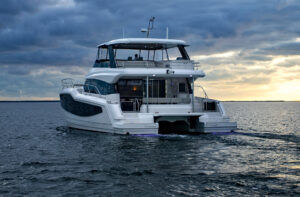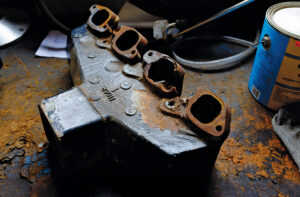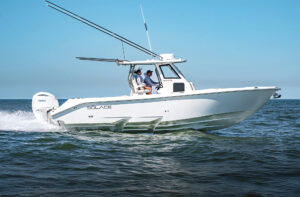Every once in a while I stop and reflect on the coverage boating publications—both print and online—devote to the proper maintenance of marine diesel engines. I don’t take issue so much with the content of these narratives as with their tone. While the authors’ intentions (mine included) are undoubtedly noble, they often leave the impression that the marine diesel engine is a finicky and fragile contraption that requires your constant surveillance and attention to keep it from devolving into a smoldering piece of scrap.

To some degree this impression is understandable. After all, what interest would you, dear reader, have in reading an engine column that said, “Your diesel engine is virtually indestructible, so quit stewing about it and go boating!”?
Still, I think it’s time to balance all those cautionary articles on diesel maintenance with one that assures you of what an amazingly simple and durable piece of hardware your diesel is and how little care and feeding it needs to do its job.
The truth is that beyond performing the recommended maintenance (basically, changing lube oil and filters), your diesel needs just two things: clean fuel and plenty of clean air. Make sure your diesel always has them and the thing will probably never so much as burp and may very well outlive you.
But simple though they may be, those two requirements are nonnegotiable because of the diesel engine’s inherent design.
You probably already know that a big difference between a gasoline engine and a diesel is that—oversimplifying here—the former requires an electrical ignition system to ignite fuel while the latter just squeezes the stuff until it gets so hot it explodes. But another big one is that in a gasoline engine, fuel is just that: a material that is burned to produce heat and power. In a diesel, fuel must do that and more, and that’s why it has to be so clean.

The diesel engine fuel-injection system includes components with tolerances measured in microns. (A micron is 1/25,000th of an inch.) The friction produced by metal components operating in such close proximity generates enough heat to quickly destroy them absent lubrication and cooling, two more jobs that fall to diesel fuel. Unlike gasoline, which is highly volatile—it evaporates very quickly—diesel fuel feels oily because it is oil, and that allows it to act as a lubricant.
Diesels circulate more fuel than the engine needs to produce power; the excess both lubricates and carries away excess heat generated by friction as it returns to the fuel tank. (In boats, heat removal is aided by passing the fuel through one or more water-cooled heat exchangers on the way to the tank.) All this is important because particulates inhibit the ability of the diesel fuel to properly lubricate.
Water can be even more damaging. If it gets into gasoline, the engine can usually manage to burn through it, although it might quake and quiver a bit. That’s not the case with diesels, primarily because they have much higher compression ratios. Water will not compress in a diesel’s combustion chambers, creating a situation commonly referred to as hydrolock. Basically it’s a case of an irresistible force meeting an immovable object, and the result is almost always a very big repair bill. Durable though they may be, diesel engines have zero tolerance for water and grit, which is why these engines have very large, expensive fuel filters, to which most prudent boaters add a fuel-water separator.
By now I hope you’re convinced of just how important it is that your diesel fuel is always free of particulates and water by the time it reaches your engine’s combustion chambers. Fortunately proper fuel maintenance is a simple three-step process: 1. Buy your fuel from a reliable source; 2. Regularly check your fuel-water separators for signs of contamination and change all fuel-filter elements per manufacturer’s recommendation; and 3. Add an approved fuel conditioner/stabilizer whenever the fuel in your tanks will sit undisturbed for more than a month.

Providing a surfeit of fresh and clean combustion air is also relatively simple, or at least it should be. To see why a proper air supply is so important, we need to return to the basics, by again comparing diesel and gasoline engines. Diesels need more air—a lot more air. Specifically, the air-to-fuel ratio of a gasoline engine is roughly 14.7:1; for a modern high-performance diesel it can be as high as 70:1. To give you some idea of what this means in the real world, a typical 8-liter turbocharged diesel turning 2300 rpm requires 975 cubic feet of fresh air per minute—that’s a volume roughly equivalent to the typical engine room. If your engines don’t get the air they need, they won’t make their rated horsepower at best and they will create some serious havoc at worst.
But it’s not just air volume that’s important; temperature is important too. As those of us who managed to stay awake during high school chemistry class learned, hot air is less dense than cold air, and a given volume of it contains less oxygen than an equivalent volume of cold air. Oxygen is what the diesel engine burns with fuel to make power. So your engine room needs to have lots of cool outside air running through it, and if your engines are big, that air should be pulled in and pushed out by fans, not the engines’ air intake systems. Maintaining a relatively cool engine room is no mean feat considering the presence of a couple of heat-producing behemoths.
Just how much air and how cool? Engine manufacturers will happily supply requirements for each of their engine models, to which boat designers are supposed to adhere. They almost always do. But anything that restricts the amount of air entering and leaving your engine room, or that raises the ambient temperature in it, will adversely affect your engines’ output and probably their longevity.
The air must be clean, too. When I began working on diesels, engine air filters were rare, the theory being that there’s little airborne dirt at sea, so there’s no need to worry about trapping it. Screens preventing loose change and other errant debris from being sucked into the engine may have sufficed back when a 150-horsepower diesel was a big deal, but not today when the average marine diesel can suck in anything within shouting distance, including those dried salt flakes on the hull. Besides, adding a filter also quiets the intake roar.
But the problem’s not just particulates. In their quenchless drive for combustion air, big diesels will pull in salt water along with salt air unless the boat has proper baffles, or better yet, demisters. If your engines are occasionally coated with a layer of fine salt, you ought to look into them.
So although a diesel engine really does need just two things to provide thousands of trouble-free hours of operation, it really needs them. When it comes to clean fuel and lots of clean, fresh air, you can’t compromise. Fortunately you don’t have to because providing them is actually pretty easy—in spite of what you may have read in those well-meaning maintenance articles.










